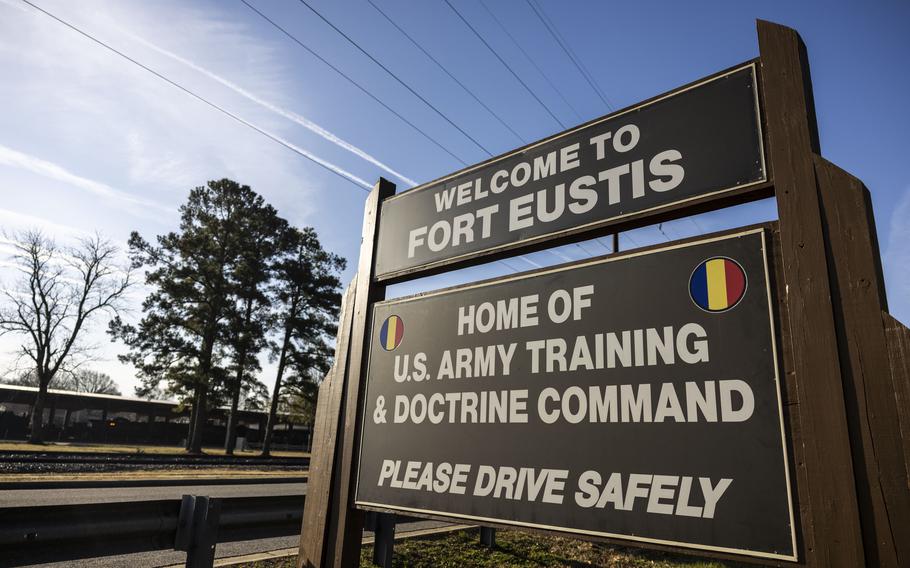
The sign for Fort Eustis is seen on base in Newport News on Thursday, Feb. 22, 2024. (Kendall Warner/The Virginian-Pilot via TNS)
(Tribune News Service) — Sergeant Major Nathan Smith still remembers joining the Army Reserve’s 5-159th General Support Aviation Battalion. It was 1997, and he was a young Chinook mechanic, fresh to Fort Eustis in Virginia.
Almost three decades later, as the battalion’s Command Sergeant Major, he’s preparing to say goodbye to the unit that shaped his military career.
Fort Eustis is set to lose its Army Reserve helicopter unit within the next year as part of an overhaul. The U.S. Army Reserve Aviation Command will inactivate the 5-159th, the largest aviation battalion in the Army Reserve, no later than September 2026.
The move is part of the Army’s Transformation Initiative, which also includes inactivation of ARAC’s two Expeditionary Combat Aviation Brigades. Inactivation means the unit will cease operations and end active service. It is not the same as deactivation — a permanent closure — though the Army currently has no plans to bring the unit back.
Smith, a Military Technician, serves in a dual civilian-military role. His unit manages and provides aviation assets to support a war effort, including air assault missions, paradrops and logistical support. They also provide training support along the East Coast.
“Anybody who does this part-time is a very special type of American,” Smith said.
Reservists typically serve just two days a month and train for two weeks a year, but many in Smith’s unit travel from as far as Montana and Texas to meet proficiency requirements, often volunteering far beyond their contractual obligations.
Roughly 450 military and civilian employees at Fort Eustis will be affected. Nationwide, about 4,500 Army Reserve Aviation Command employees across 11 states will be reassigned, which is two-thirds of the aviation command’s workforce. It is headquartered in Fort Knox, Ky.
While the jobs in inactivated units will cease, Chief Public Affairs Officer Maj. Jeffrey Windmueller said the Army is working to find new roles for affected personnel. Some may remain in the branch and retrain, and others may transfer.
“We’re doing everything in our power to make sure people who want to stay in the Army Reserve can,” Windmueller said.
The Army has been offering conditional releases to allow service members to transfer between components and branches. Smith said his unit has also organized meetings and resources to help members navigate the transition.
“There is an amazing buy-in on helping every single one of our soldiers find something new,” he said.
Fixed-wing units will remain active, and ARAC’s training and operations will continue for now.
In a May 13 letter, aviation command Commanding General Brig. Gen. Roger F. Deon Jr. acknowledged concerns and said he is “actively seeking clarification on the future of these operational missions.”
It’s part of a broader overhaul. Other changes coming to Fort Eustis include relocating the headquarters of the Army Training and Doctrine Command. It will merge with Army Futures Command in Austin, Texas, to form the new Army Transformation and Training Command. The Army hasn’t said how many Fort Eustis-based service members will be affected.
“The Army is always restructuring,” Windmueller said.
Millions of dollars worth of equipment from the 5-159th will be reallocated. The unit’s CH-47 Chinooks, UH-60 Black Hawks and HH-60 MEDEVAC helicopters may be transferred to other military branches, Border Patrol, or be sold privately.
Announced April 30 by Defense Secretary Pete Hegseth, the plan calls for divestment from “wasteful spending,” including outdated technologies and redundant workforce structures. It aims to make the Army a “leaner, more lethal” force.
The next day, Army Chief of Staff Gen. Randy A. George and Secretary Dan Driscoll outlined a strategy to prioritize investments in areas like missile defense, cyber, and counter-space capabilities, including support for President Trump’s proposed Golden Dome defense system.
“How many helicopters do you see flying around Ukraine? None,” Smith said. “The face of national security is changing. This is one of those necessary changes.”
Smith praised the flexibility of his fellow service members, noting that they are used to change.
When asked what’s next for him, Smith said: “I ask myself that all the time.”
He may choose to retire or continue serving elsewhere. For others, the path forward may be less clear.
“People that come here live and breathe flying Army helicopters,” he added. “Depending on where they are in their careers, the sentiment is, well, now what am I going to do?”
©2025 The Virginian-Pilot.
Visit pilotonline.com.
Distributed by Tribune Content Agency, LLC.